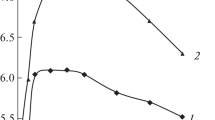Abstract
A new solid-state sensor for potentiometric determination of surfactants with a layer of multi-walled carbon nanotubes was prepared. As a sensing material, 1,3-didecyl-2-methylimidazolium–tetraphenylborate ion-pair was used. The investigated sensor showed a Nernstian response for both dodecylbenzenesulphonate (DBS, 57.6 mV/decade of activity between 5 × 10−7 to 1 × 10−3 M) and sodium lauryl sulfate (LS, 58.4 mV/decade of activity between 2 × 10−7 to 2 × 10−3 M). It responded in 8–10 s for each ten-fold concentration change in the range of 1 × 10−6 to 3 × 10−3 M. The detection limits for DS and DBS were 2 × 10−7 and 3 × 10−7 M, respectively. The sensor revealed a stable response (signal drift 2.6 mV/h) and exhibited satisfactory selectivity performances for LS over most of the anions generally used in surfactant-based commercial detergents. The main application of this sensor was the end-point determination in potentiometric titrations of anionic surfactants. The (diisobutyl phenoxy ethoxy ethyl)dimethyl benzyl ammonium chloride (Hyamine), cetyltrimethylammonium bromide, hexadecylpyridinium chloride monohydrate (HDPC) and 1,3-didecyl-2-methylimidazolium chloride were tested as potential cationic titrants, and all exhibited analytically usable titration curves with well-defined equivalence points. The standard solution of HDPC was used as a cationic titrant by all potentiometric titrations. The operational life-time of the sensor described was prolonged to more than 3 months.






Similar content being viewed by others
References
Kutsch O. Ceresana Research, market study: surfactants. 2nd ed. Ceresana; 2015.
Research and Markets. Surfactants Market by Type (Anionic, Non-Ionic, Cationic, and Amphoteric), Substrate (Synthetic, and Bio-based), Application (Detergents, Personal Care, Textile, Elastomers & Plastics, Crop Protection, Food & Beverage) - Global Forecast to 2021, Markets and Markets; 2016.
Nazar MF, Mukhtar F, Chaudry S, et al. Biophysical probing of antibacterial Gemifloxacin assimilated in surfactant mediated molecular assemblies. J Mol Liq. 2014;200:361–8. doi:10.1016/j.molliq.2014.11.007.
International Organization for Standardization. Water quality, determination of surfactants, Part 1: determination of anionic surfactants by the methylene blue spectrometric method, ISO 7875/1. Geneva: Switzerland; 1984.
International Organization for Standardization Surface active agents. Detergents, determination of anionic-active matter by manual or mechanical direct two-phase titration procedure, ISO 2271. Geneva: Switzerland; 1989.
Mohamed GG, Ali TA, El-Shahat MF, et al. Potentiometric determination of cetylpyridinium chloride using a new type of screen-printed ion selective electrodes. Anal Chim Acta. 2010;673:79–87. doi:10.1016/j.aca.2010.05.016.
Sak-Bosnar M, Madunić-Čačić D, Sakač N, et al. Potentiometric sensor for polyethoxylated nonionic surfactant determination. Electrochim Acta. 2009;55:528–34. doi:10.1016/j.electacta.2009.09.010.
Abbas M, Mostafa GA, Homoda AM. Cetylpyridinium–iodomercurate PVC membrane ion selective electrode for the determination of cetylpyridinium cation in Ezafluor mouth wash and as a detector for some potentiometric titrations. Talanta. 2000;53:425–32. doi:10.1016/S0039-9140(00)00496-3.
Gerlache M, Sentürk Z, Viré JC, Kauffmann JM. Potentiometric analysis of ionic surfactants by a new type of ion-selective electrode. Anal Chim Acta. 1997;349:59–65. doi:10.1016/S0003-2670(97)00277-8.
Seguí MAJ, Lizondo-Sabater J, Benito A, et al. A new ion-selective electrode for anionic surfactants. Talanta. 2007;71:333–8. doi:10.1016/j.talanta.2006.04.005.
Alonso J, Baró J, Bartrolí J, et al. Flow-through tubular ion-selective electrodes responsive to anionic surfactants for flow-injection analysis. Anal Chim Acta. 1995;308:115–21. doi:10.1016/0003-2670(94)00601-H.
Abounassif MA, Hefnawy MM, Al-Robian H, Mostafa GAE. Dodecanthiol as novel sensing material for potentiometric determination of sodium dodecyl sulphate anionic surfactant. Int J Electrochem Sci. 2015;10:8668–79.
Kovács B, Csóka B, Nagy G, Ivaska A. All-solid-state surfactant sensing electrode using conductive polymer as internal electric contact. Anal Chim Acta. 2001;437:67–76. doi:10.1016/S0003-2670(01)00987-4.
Zielińska R, Mulik E, Michalska A, et al. All-solid-state planar miniature ion-selective chloride electrode. Anal Chim Acta. 2002;451:243–9. doi:10.1016/S0003-2670(01)01407-6.
Yin T, Qin W. Applications of nanomaterials in potentiometric sensors. Trends Anal Chem. 2013;51:79–86. doi:10.1016/j.trac.2013.06.009.
Zhao Q, Gan Z, Zhuang Q. Electrochemical sensors based on carbon nanotubes. Electroanalysis. 2002;14:1609–13. doi:10.1002/elan.200290000.
Crespo GA, Macho S, Rius FX. Ion-selective electrodes using carbon nanotubes as ion-to-electron transducers. Anal Chem. 2008;80:1316–22.
Yin T, Qin W. Applications of nanomaterials in potentiometric sensors. Trends Anal Chem. 2013;51:79–86. doi:10.1016/j.trac.2013.06.009.
Zhu J, Qin Y, Zhang Y. Preparation of all solid-state potentiometric ion sensors with polymer-CNT composites. Electrochem Commun. 2009;11:1684–7. doi:10.1016/j.elecom.2009.06.025.
Rius-ruiz FX, Crespo A, Bejarano-nosas D, et al. Potentiometric strip cell based on carbon nanotubes as transducer. Anal Chem. 2011;83:8810–5. doi:10.1021/ac202070r.
Hernández R, Riu J, Rius FX. Determination of calcium ion in sap using carbon nanotube-based ion-selective electrodes. Analyst. 2010;135:1979–85. doi:10.1039/c0an00148a.
Guinovart T, Parrilla M, Crespo GA, et al. Potentiometric sensors using cotton yarns, carbon nanotubes and polymeric membranes. Analyst. 2013;138:5208. doi:10.1039/c3an00710c.
Najafi M, Maleki L, Rafati AA. Novel surfactant selective electrochemical sensors based on single walled carbon nanotubes. J Mol Liq. 2011;159:226–9. doi:10.1016/j.molliq.2011.01.013.
Galović O, Samardžić M, Hajduković M, Sak-Bosnar M. A new graphene-based surfactant sensor for the determination of anionic surfactants in real samples. Sensors Actuators B. 2016;236:257–67. doi:10.1016/j.snb.2016.05.166.
Madunić Čačić D, Sak-Bosnar M, Galović O, et al. Determination of cationic surfactants in pharmaceutical disinfectants using a new sensitive potentiometric sensor. Talanta. 2008;76:259–64. doi:10.1016/j.talanta.2008.02.023.
Guilbault GG, Durst RA, Frant MS, Freiser H, Hansen EH, Light TS, Pungor E, Rechnitz G, Rice NM, Rohm TJ, Simon W. Recommendations for nomenclature of ion-selective electrodes. Pure Appl Chem. 1976;48:127–32.
Umezawa Y, Bühlmann P, Umezawa K, et al. Potentiometric selectivity coefficients of ion-selective electrodes. Part I. inorganic cations (technical report). Pure Appl Chem. 2000. doi:10.1351/pac200072101851.
Kargosha K, Ahmadi SH, Mansourian M, Azad J. Simultaneous determination of one nonionic and two anionic surfactants using Fourier transform infrared spectrometry and multivariate analysis. Talanta. 2008;75:589–93. doi:10.1016/j.talanta.2007.11.065.
Acknowledgements
This work has been supported by the Croatian Science Foundation under the project IP-11-2013.
Author information
Authors and Affiliations
Corresponding author
About this article
Cite this article
Sakač, N., Jozanović, M., Karnaš, M. et al. A New Sensor for Determination of Anionic Surfactants in Detergent Products with Carbon Nanotubes as Solid Contact. J Surfact Deterg 20, 881–889 (2017). https://doi.org/10.1007/s11743-017-1978-0
Received:
Accepted:
Published:
Issue Date:
DOI: https://doi.org/10.1007/s11743-017-1978-0



